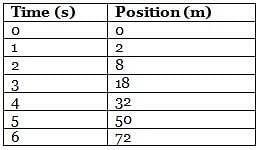MCAT Exam > MCAT Questions > The branch of physics that studies the motion...
Start Learning for Free
The branch of physics that studies the motion of a body without taking into account the causes of that motion is called kinematics. According to kinematics, the position and velocity of a moving body is described by the following equations:

Where Xo and Xf are the initial and final positions of the body, Vo and Vf are the initial and final velocities of the body, a is the acceleration of the body, and t is the time.
According to classical mechanics, developed by Isaac Newton, the product of the mass and the acceleration of a body can be described by the following equation (Newton’s second law):
m⋅a = ΣF
Where m is the mass, a is the acceleration, and ΣF is the sum of all forces acting on the body.
The following table shows the position at different times of a 80-kg hospital bed with a 40-kg patient on top of it that is being pushed from rest by a doctor on a rough floor that exerts a constant friction force of 600 N.


Where Xo and Xf are the initial and final positions of the body, Vo and Vf are the initial and final velocities of the body, a is the acceleration of the body, and t is the time.
According to classical mechanics, developed by Isaac Newton, the product of the mass and the acceleration of a body can be described by the following equation (Newton’s second law):
m⋅a = ΣF
Where m is the mass, a is the acceleration, and ΣF is the sum of all forces acting on the body.
The following table shows the position at different times of a 80-kg hospital bed with a 40-kg patient on top of it that is being pushed from rest by a doctor on a rough floor that exerts a constant friction force of 600 N.

Q. What forces are acting on the hospital bed in the attachment?
- a)push by the doctor and friction
- b)push by the doctor, friction, and weight of the bed
- c)push by the doctor, friction, weight of the bed, weight of the patient, and normal
- d)friction, weight of the patient, and normal
Correct answer is option 'C'. Can you explain this answer?
| FREE This question is part of | Download PDF Attempt this Test |
Most Upvoted Answer
The branch of physics that studies the motion of a body without taking...
If a free body diagram is drawn for the hospital bed, there are five forces acting on the hospital bed: The push by the doctor, pointing to the right; friction, pointing left; weight of the bed and weight of the patient, pointing down; and normal, pointing up.
Attention MCAT Students!
To make sure you are not studying endlessly, EduRev has designed MCAT study material, with Structured Courses, Videos, & Test Series. Plus get personalized analysis, doubt solving and improvement plans to achieve a great score in MCAT.

|
Explore Courses for MCAT exam
|

|
The branch of physics that studies the motion of a body without taking into account the causes of that motion is called kinematics. According to kinematics, the position and velocity of a moving body is described by the following equations:Where Xoand Xfare the initial and final positions of the body, Voand Vfare the initial and final velocities of the body, ais the acceleration of the body, and tis the time.According to classical mechanics, developed by Isaac Newton, the product of the mass and the acceleration of a body can be described by the following equation (Newton’s second law):m⋅a = ΣFWhere mis the mass, ais the acceleration, and ΣFis the sum of all forces acting on the body.The following table shows the position at different times of a 80-kg hospital bed with a 40-kg patient on top of it that is being pushed from rest by a doctor on a rough floor that exerts a constant friction force of 600N.Q.What forces are acting on the hospital bed in the attachment?a)push by the doctor and frictionb)push by the doctor, friction, and weight of the bedc)push by the doctor, friction, weight of the bed, weight of the patient, and normald)friction, weight of the patient, and normalCorrect answer is option 'C'. Can you explain this answer?
Question Description
The branch of physics that studies the motion of a body without taking into account the causes of that motion is called kinematics. According to kinematics, the position and velocity of a moving body is described by the following equations:Where Xoand Xfare the initial and final positions of the body, Voand Vfare the initial and final velocities of the body, ais the acceleration of the body, and tis the time.According to classical mechanics, developed by Isaac Newton, the product of the mass and the acceleration of a body can be described by the following equation (Newton’s second law):m⋅a = ΣFWhere mis the mass, ais the acceleration, and ΣFis the sum of all forces acting on the body.The following table shows the position at different times of a 80-kg hospital bed with a 40-kg patient on top of it that is being pushed from rest by a doctor on a rough floor that exerts a constant friction force of 600N.Q.What forces are acting on the hospital bed in the attachment?a)push by the doctor and frictionb)push by the doctor, friction, and weight of the bedc)push by the doctor, friction, weight of the bed, weight of the patient, and normald)friction, weight of the patient, and normalCorrect answer is option 'C'. Can you explain this answer? for MCAT 2024 is part of MCAT preparation. The Question and answers have been prepared according to the MCAT exam syllabus. Information about The branch of physics that studies the motion of a body without taking into account the causes of that motion is called kinematics. According to kinematics, the position and velocity of a moving body is described by the following equations:Where Xoand Xfare the initial and final positions of the body, Voand Vfare the initial and final velocities of the body, ais the acceleration of the body, and tis the time.According to classical mechanics, developed by Isaac Newton, the product of the mass and the acceleration of a body can be described by the following equation (Newton’s second law):m⋅a = ΣFWhere mis the mass, ais the acceleration, and ΣFis the sum of all forces acting on the body.The following table shows the position at different times of a 80-kg hospital bed with a 40-kg patient on top of it that is being pushed from rest by a doctor on a rough floor that exerts a constant friction force of 600N.Q.What forces are acting on the hospital bed in the attachment?a)push by the doctor and frictionb)push by the doctor, friction, and weight of the bedc)push by the doctor, friction, weight of the bed, weight of the patient, and normald)friction, weight of the patient, and normalCorrect answer is option 'C'. Can you explain this answer? covers all topics & solutions for MCAT 2024 Exam. Find important definitions, questions, meanings, examples, exercises and tests below for The branch of physics that studies the motion of a body without taking into account the causes of that motion is called kinematics. According to kinematics, the position and velocity of a moving body is described by the following equations:Where Xoand Xfare the initial and final positions of the body, Voand Vfare the initial and final velocities of the body, ais the acceleration of the body, and tis the time.According to classical mechanics, developed by Isaac Newton, the product of the mass and the acceleration of a body can be described by the following equation (Newton’s second law):m⋅a = ΣFWhere mis the mass, ais the acceleration, and ΣFis the sum of all forces acting on the body.The following table shows the position at different times of a 80-kg hospital bed with a 40-kg patient on top of it that is being pushed from rest by a doctor on a rough floor that exerts a constant friction force of 600N.Q.What forces are acting on the hospital bed in the attachment?a)push by the doctor and frictionb)push by the doctor, friction, and weight of the bedc)push by the doctor, friction, weight of the bed, weight of the patient, and normald)friction, weight of the patient, and normalCorrect answer is option 'C'. Can you explain this answer?.
The branch of physics that studies the motion of a body without taking into account the causes of that motion is called kinematics. According to kinematics, the position and velocity of a moving body is described by the following equations:Where Xoand Xfare the initial and final positions of the body, Voand Vfare the initial and final velocities of the body, ais the acceleration of the body, and tis the time.According to classical mechanics, developed by Isaac Newton, the product of the mass and the acceleration of a body can be described by the following equation (Newton’s second law):m⋅a = ΣFWhere mis the mass, ais the acceleration, and ΣFis the sum of all forces acting on the body.The following table shows the position at different times of a 80-kg hospital bed with a 40-kg patient on top of it that is being pushed from rest by a doctor on a rough floor that exerts a constant friction force of 600N.Q.What forces are acting on the hospital bed in the attachment?a)push by the doctor and frictionb)push by the doctor, friction, and weight of the bedc)push by the doctor, friction, weight of the bed, weight of the patient, and normald)friction, weight of the patient, and normalCorrect answer is option 'C'. Can you explain this answer? for MCAT 2024 is part of MCAT preparation. The Question and answers have been prepared according to the MCAT exam syllabus. Information about The branch of physics that studies the motion of a body without taking into account the causes of that motion is called kinematics. According to kinematics, the position and velocity of a moving body is described by the following equations:Where Xoand Xfare the initial and final positions of the body, Voand Vfare the initial and final velocities of the body, ais the acceleration of the body, and tis the time.According to classical mechanics, developed by Isaac Newton, the product of the mass and the acceleration of a body can be described by the following equation (Newton’s second law):m⋅a = ΣFWhere mis the mass, ais the acceleration, and ΣFis the sum of all forces acting on the body.The following table shows the position at different times of a 80-kg hospital bed with a 40-kg patient on top of it that is being pushed from rest by a doctor on a rough floor that exerts a constant friction force of 600N.Q.What forces are acting on the hospital bed in the attachment?a)push by the doctor and frictionb)push by the doctor, friction, and weight of the bedc)push by the doctor, friction, weight of the bed, weight of the patient, and normald)friction, weight of the patient, and normalCorrect answer is option 'C'. Can you explain this answer? covers all topics & solutions for MCAT 2024 Exam. Find important definitions, questions, meanings, examples, exercises and tests below for The branch of physics that studies the motion of a body without taking into account the causes of that motion is called kinematics. According to kinematics, the position and velocity of a moving body is described by the following equations:Where Xoand Xfare the initial and final positions of the body, Voand Vfare the initial and final velocities of the body, ais the acceleration of the body, and tis the time.According to classical mechanics, developed by Isaac Newton, the product of the mass and the acceleration of a body can be described by the following equation (Newton’s second law):m⋅a = ΣFWhere mis the mass, ais the acceleration, and ΣFis the sum of all forces acting on the body.The following table shows the position at different times of a 80-kg hospital bed with a 40-kg patient on top of it that is being pushed from rest by a doctor on a rough floor that exerts a constant friction force of 600N.Q.What forces are acting on the hospital bed in the attachment?a)push by the doctor and frictionb)push by the doctor, friction, and weight of the bedc)push by the doctor, friction, weight of the bed, weight of the patient, and normald)friction, weight of the patient, and normalCorrect answer is option 'C'. Can you explain this answer?.
Solutions for The branch of physics that studies the motion of a body without taking into account the causes of that motion is called kinematics. According to kinematics, the position and velocity of a moving body is described by the following equations:Where Xoand Xfare the initial and final positions of the body, Voand Vfare the initial and final velocities of the body, ais the acceleration of the body, and tis the time.According to classical mechanics, developed by Isaac Newton, the product of the mass and the acceleration of a body can be described by the following equation (Newton’s second law):m⋅a = ΣFWhere mis the mass, ais the acceleration, and ΣFis the sum of all forces acting on the body.The following table shows the position at different times of a 80-kg hospital bed with a 40-kg patient on top of it that is being pushed from rest by a doctor on a rough floor that exerts a constant friction force of 600N.Q.What forces are acting on the hospital bed in the attachment?a)push by the doctor and frictionb)push by the doctor, friction, and weight of the bedc)push by the doctor, friction, weight of the bed, weight of the patient, and normald)friction, weight of the patient, and normalCorrect answer is option 'C'. Can you explain this answer? in English & in Hindi are available as part of our courses for MCAT.
Download more important topics, notes, lectures and mock test series for MCAT Exam by signing up for free.
Here you can find the meaning of The branch of physics that studies the motion of a body without taking into account the causes of that motion is called kinematics. According to kinematics, the position and velocity of a moving body is described by the following equations:Where Xoand Xfare the initial and final positions of the body, Voand Vfare the initial and final velocities of the body, ais the acceleration of the body, and tis the time.According to classical mechanics, developed by Isaac Newton, the product of the mass and the acceleration of a body can be described by the following equation (Newton’s second law):m⋅a = ΣFWhere mis the mass, ais the acceleration, and ΣFis the sum of all forces acting on the body.The following table shows the position at different times of a 80-kg hospital bed with a 40-kg patient on top of it that is being pushed from rest by a doctor on a rough floor that exerts a constant friction force of 600N.Q.What forces are acting on the hospital bed in the attachment?a)push by the doctor and frictionb)push by the doctor, friction, and weight of the bedc)push by the doctor, friction, weight of the bed, weight of the patient, and normald)friction, weight of the patient, and normalCorrect answer is option 'C'. Can you explain this answer? defined & explained in the simplest way possible. Besides giving the explanation of
The branch of physics that studies the motion of a body without taking into account the causes of that motion is called kinematics. According to kinematics, the position and velocity of a moving body is described by the following equations:Where Xoand Xfare the initial and final positions of the body, Voand Vfare the initial and final velocities of the body, ais the acceleration of the body, and tis the time.According to classical mechanics, developed by Isaac Newton, the product of the mass and the acceleration of a body can be described by the following equation (Newton’s second law):m⋅a = ΣFWhere mis the mass, ais the acceleration, and ΣFis the sum of all forces acting on the body.The following table shows the position at different times of a 80-kg hospital bed with a 40-kg patient on top of it that is being pushed from rest by a doctor on a rough floor that exerts a constant friction force of 600N.Q.What forces are acting on the hospital bed in the attachment?a)push by the doctor and frictionb)push by the doctor, friction, and weight of the bedc)push by the doctor, friction, weight of the bed, weight of the patient, and normald)friction, weight of the patient, and normalCorrect answer is option 'C'. Can you explain this answer?, a detailed solution for The branch of physics that studies the motion of a body without taking into account the causes of that motion is called kinematics. According to kinematics, the position and velocity of a moving body is described by the following equations:Where Xoand Xfare the initial and final positions of the body, Voand Vfare the initial and final velocities of the body, ais the acceleration of the body, and tis the time.According to classical mechanics, developed by Isaac Newton, the product of the mass and the acceleration of a body can be described by the following equation (Newton’s second law):m⋅a = ΣFWhere mis the mass, ais the acceleration, and ΣFis the sum of all forces acting on the body.The following table shows the position at different times of a 80-kg hospital bed with a 40-kg patient on top of it that is being pushed from rest by a doctor on a rough floor that exerts a constant friction force of 600N.Q.What forces are acting on the hospital bed in the attachment?a)push by the doctor and frictionb)push by the doctor, friction, and weight of the bedc)push by the doctor, friction, weight of the bed, weight of the patient, and normald)friction, weight of the patient, and normalCorrect answer is option 'C'. Can you explain this answer? has been provided alongside types of The branch of physics that studies the motion of a body without taking into account the causes of that motion is called kinematics. According to kinematics, the position and velocity of a moving body is described by the following equations:Where Xoand Xfare the initial and final positions of the body, Voand Vfare the initial and final velocities of the body, ais the acceleration of the body, and tis the time.According to classical mechanics, developed by Isaac Newton, the product of the mass and the acceleration of a body can be described by the following equation (Newton’s second law):m⋅a = ΣFWhere mis the mass, ais the acceleration, and ΣFis the sum of all forces acting on the body.The following table shows the position at different times of a 80-kg hospital bed with a 40-kg patient on top of it that is being pushed from rest by a doctor on a rough floor that exerts a constant friction force of 600N.Q.What forces are acting on the hospital bed in the attachment?a)push by the doctor and frictionb)push by the doctor, friction, and weight of the bedc)push by the doctor, friction, weight of the bed, weight of the patient, and normald)friction, weight of the patient, and normalCorrect answer is option 'C'. Can you explain this answer? theory, EduRev gives you an
ample number of questions to practice The branch of physics that studies the motion of a body without taking into account the causes of that motion is called kinematics. According to kinematics, the position and velocity of a moving body is described by the following equations:Where Xoand Xfare the initial and final positions of the body, Voand Vfare the initial and final velocities of the body, ais the acceleration of the body, and tis the time.According to classical mechanics, developed by Isaac Newton, the product of the mass and the acceleration of a body can be described by the following equation (Newton’s second law):m⋅a = ΣFWhere mis the mass, ais the acceleration, and ΣFis the sum of all forces acting on the body.The following table shows the position at different times of a 80-kg hospital bed with a 40-kg patient on top of it that is being pushed from rest by a doctor on a rough floor that exerts a constant friction force of 600N.Q.What forces are acting on the hospital bed in the attachment?a)push by the doctor and frictionb)push by the doctor, friction, and weight of the bedc)push by the doctor, friction, weight of the bed, weight of the patient, and normald)friction, weight of the patient, and normalCorrect answer is option 'C'. Can you explain this answer? tests, examples and also practice MCAT tests.

|
Explore Courses for MCAT exam
|

|
Signup for Free!
Signup to see your scores go up within 7 days! Learn & Practice with 1000+ FREE Notes, Videos & Tests.






















